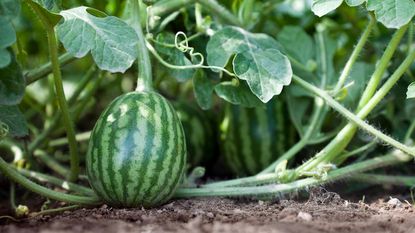Watermelon Growing Problems: 5 Melon Mistakes Made In The Garden


A sweet, juicy slice of watermelon on a hot summer day evokes iconic thoughts of simpler times. Whether you want to capture moments like these or you simply enjoy the sugary embrace of this delectable fruit, growing your own watermelon is a cost efficient way of providing fruit for your family. But if you haven't had much success growing melon in the past, the reason might be one of these common melon mistakes.
Common Watermelon Growing Problems
Here's a breakdown of the 5 most common cultivation issues with watermelons, complete with the solutions needed to correct these melon mistakes:
1. Improper Planting
Poor germination, slow growth or loss of plants can usually be traced back to planting issues with watermelons. To prevent these problems, plant watermelons in loose, organically-rich soil. Work plenty of compost and organic material into the bed to loosen the soil and to provide the nutrients melon plants crave.
Watermelon prefers hot weather and many varieties require at least 100 days to produce fruit. In climates with shorter growing seasons, start seeds indoors. The use of biodegradable pots will reduce stress when transplanting seedlings into the garden. Plant watermelon in raised hills once all danger of frost has passed.
2. Neglecting Weeds
Weeds not only compete with watermelon plants for nutrients and growing space, they also harbor harmful pests and diseases. Watermelon plants have a moderately deep root system, so pulling weeds around watermelons is not as problematic as it is with more shallow-rooted garden plants.
Use mulch to reduce weeding chores and conserve moisture. Mulch provides a barrier which deters pests and provides a dry resting place for developing fruit. Grass clippings or straw mulches decompose within a year and replenish the soil with beneficial nutrients.
3. Inconsistent Soil Moisture Levels
A consistently moist, but not soggy, soil helps watermelon plants grow quickly. This keeps the plants healthy by reducing the amount of time for pests and disease to attack. Consistent moisture levels also allow the fruit to steadily increase in size.
Gardening tips, videos, info and more delivered right to your inbox!
Sign up for the Gardening Know How newsletter today and receive a free download of our most popular eBook "How to Grow Delicious Tomatoes."
Fruit cracking on the vine is indicative of hot, dry spells followed by heavy rain. Provide supplemental water during dry spells to prevent the soil from drying out completely. The root system of a watermelon extends beyond the base of the plant. Be sure to apply water in a ring around the plant, not just where the stem emerges from the ground.
4. Ignoring Pests and Disease
Periodically checking the melon patch for signs of diseases or pest damage will allow you to address the issues with watermelons before they become widespread. Leaf damage is one of the most common signs of disease and insect infestation. Missing leaves are more likely due to deer.
The best way to deter insects and disease is to keep plants healthy and growing fast. If these problems still exist, opt for organic methods of control whenever possible. Chemical pesticides also kill pollinators and can result in poor yields due to low fruit set.
5. Harvesting at the Wrong Time
Picking watermelons too soon or waiting too long are common melon mistakes. To pick melons at the peak of ripeness, look at the curly tendrils nearest the fruit. When they turn brown, the plant is no longer feeding the melon.

Laura Miller has been gardening all her life. Holding a degree in Biology, Nutrition, and Agriculture, Laura's area of expertise is vegetables, herbs, and all things edible. She lives in Ohio.
-
 Want a Backyard Mini Orchard? Create Your Own Container Orchard
Want a Backyard Mini Orchard? Create Your Own Container OrchardEasier to care for in small spaces, a backyard mini-orchard makes sense for busy gardeners and juicy fruit is the reward.
By Teo Spengler
-
 Urban Beekeeping Guide: Top Tips For Raising Bees In The City
Urban Beekeeping Guide: Top Tips For Raising Bees In The CityUrban beekeeping can be a rewarding and appreciated pastime, but first be sure it’s legal in your city and learn the ropes of beekeeping.
By Mary Ellen Ellis